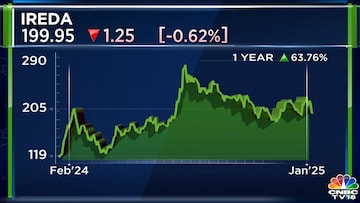
Current net NPAs stand at 1.5% and gross NPAs at 2.7%, he is confident of further reductions.
Das emphasised steady net interest margins (NIMs) of 3-3.5%, driven by disciplined project evaluation and monitoring processes. IREDA’s AUM grew 36% year-on-year, with disbursements projected to cross ₹29,000-30,000 crore for 2024-25 (FY25).
The company is optimistic about further reducing borrowing costs with 54EC tax recognition.
Looking ahead, IREDA has a strong project pipeline of 50 GW, with 42% already tied to PPAs, reinforcing confidence in future growth.

The company is set to target its Qualified Institutional Placement (QIP) during the ongoing January-March quarter.
Below is the transcript of the interview.
Q: You have mentioned net NPAs around 1.5% and gross NPAs around 2.7%. Going ahead, what do you see these numbers cool off to and also help us out for what are the slippages number, the write-offs number for the past quarter?
A: Only ₹433 crore new NPA has been added. Going ahead, we are confident this number is going to come down. If you see last almost 18 quarters, we had been reducing the NPA gradually, and not by just settling with any kind of haircuts and all.
More than 95% of our NPA account, wherever we have gone for settlement, we have either realised the principal cost of funds or principals on interest or principal cost of loss and certain amount of margin there. So that was the approach to settle the account in last 18 quarters and 18 quarters continuously, reduction was happening.
Only this quarter, it has gone up because of one group’s account, and we are quite confident that by March, we will again work out to bring down the NPA.
Q: Slippages and write offs in the past quarter. You want to give us that number?
A: Slippages are pertaining to prior to 2020 census and all. And if you see last four, five years, whatever sanction we have done, or disbursement we have done, we do not have any major NPA or slippages. So therefore, I do not foresee that any kind of major slippages in the time to come.
Q: Let us talk about both the outlook for disbursals and also margins. Your margins in the reported numbers were looking very steady, 3.3% what is the funding environment like and what is the expectation that you have?
A: We have been focusing on between 3% and 3.5%. Our focus is to develop the sector, and we have been focusing fair amount of margin of 3-3.5% and our net interest margins (NIMs) is always rangebound – continuously and consistently. We have the opportunity to enhance the rate in emerging sector – we are the first choice by the developer to look at when it is new and emerging. If we enhance the rate, we will have a better margin. But then the project, which is becoming bankable, may not become bankable. That is the prime responsibility with us.
Also Read | Borosil Renewables exec details capacity expansion plans, revenue outlook
Fair amount of business opportunities are there if we work with a disciplined approach and the way we have executed in the last 37 years, particularly last four and a half years, I am quite confident our business is going to continue to have that kind of steady growth.
Our sanction has gone up more than 100% and disbursement profit is always 30 plus and around. So that kind of continuous and consecutive growth we are showing that speaks about robust due diligence process and robust project review, monitoring and catching the early warning signals also.
Q: This time your AUM growth is 36% year on year (YoY), for 2024-25 (FY25) what will be the AUM growth? And if you could just give us a margin range as well for the year as a whole?
A: You are asking for 2024-25, we have given up to 2030.
Q: That is the long term picture. In the near term, what are the levels that your shareholders can look out for?
A: What we have given to government of India and signed MoU with them is around ₹29,000-30,000 crore that we are going to disburse already ₹18,000 crore we have crossed. If you look at four years back, we used to do only ₹8,500 crore in a year, and last year, we have done around ₹25,000 crore. So this time we are having internal target of much more than that. So, we are confident of looking into that kind of figures. And as far as NIM is concerned, our borrowing cost has been reduced.
Going forward, we are looking into various options, both domestic as well as overseas lending. Now we want to reduce further. And again, we hope in this budget we get that 54EC recognition (which allows tax exemptions for investors on capital gains by investing in designated bonds) that will further help us to reduce our borrowing cost, and we are quite confident of further reducing the borrowing cost, if not sustaining that.
Second, we have fair amount of pipeline of sanctions with us, and we did almost 50 gigawatt, and 42% of that has already been power purchase agreement-signed (PPA). So fair amount of business is there, and we are quite confident to reach the figures what we have planned.
For more, watch the accompanying video



